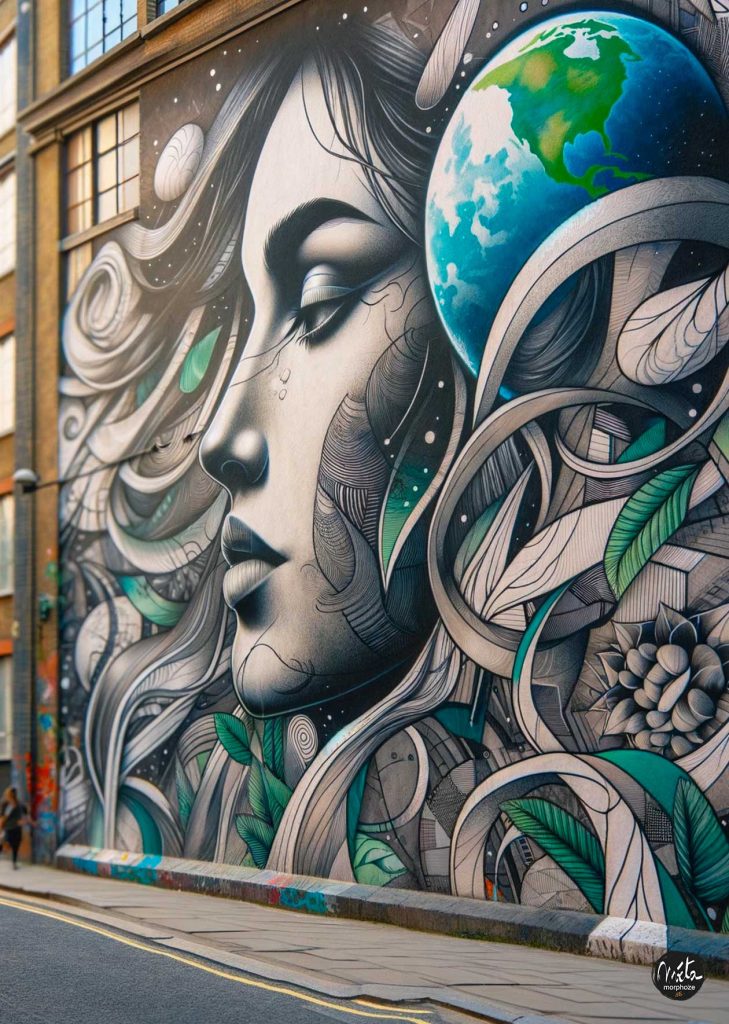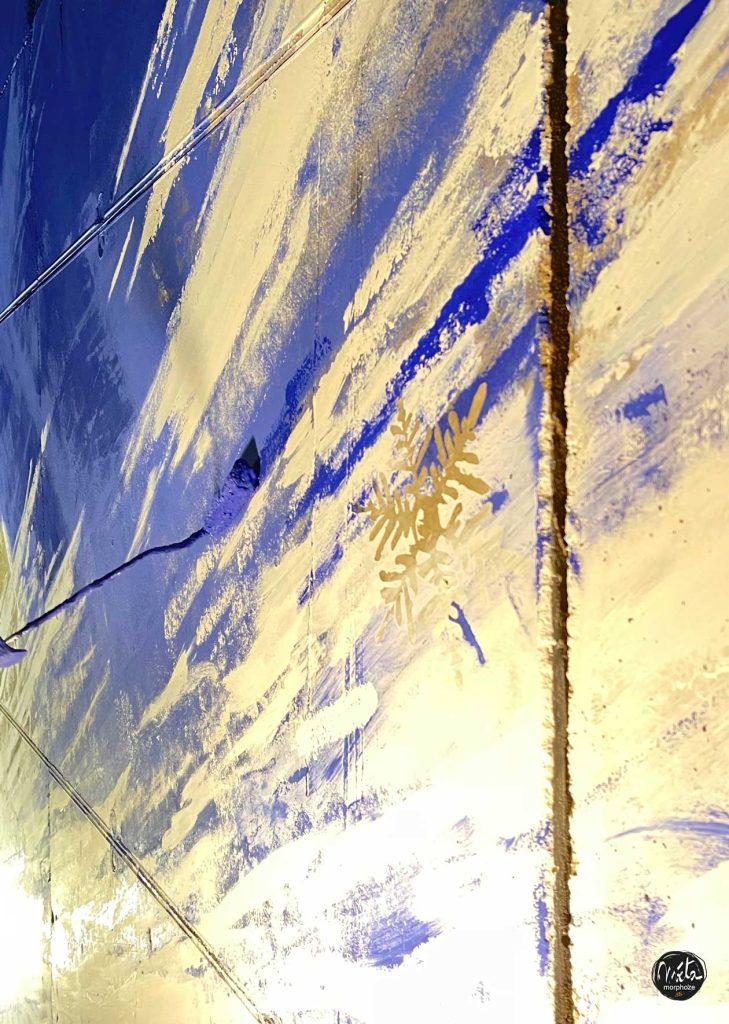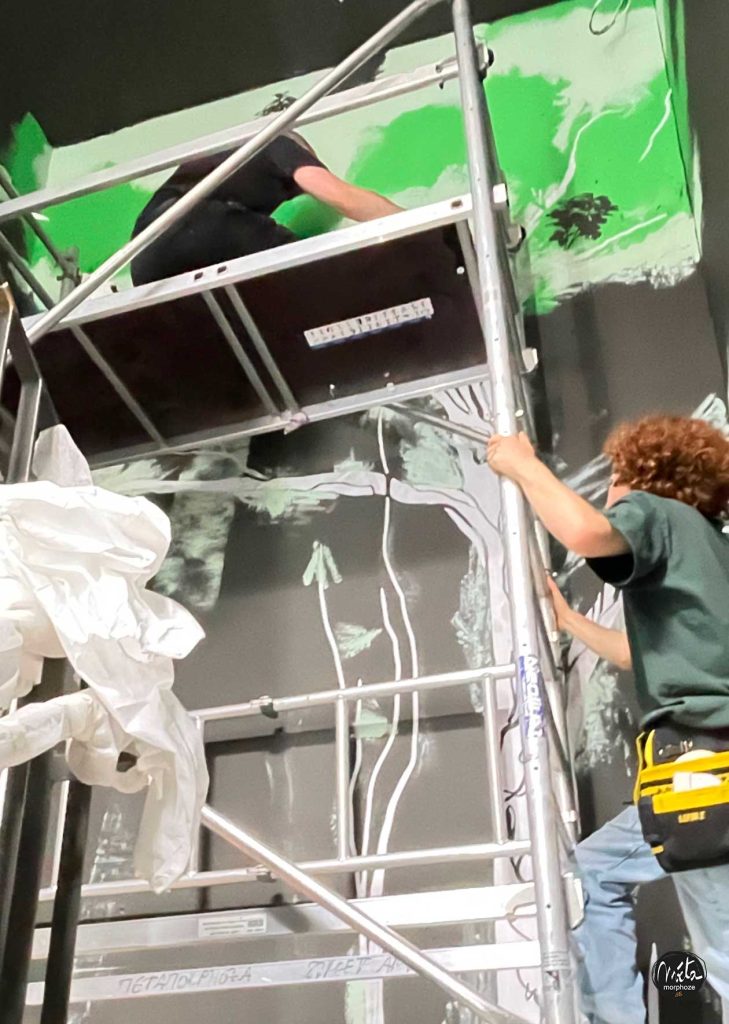The benefits of hand-painted murals in private and public establishments
Hand-painted murals are becoming increasingly popular in many establishments, both private and public. They stand out for their uniqueness and their ability to transform spaces into monumental works of art, while conveying powerful messages and creating inspiring environments. Whether in schools, hospitals, businesses or administrative buildings, murals become vectors of communication, well-being and identity. In this article, we explore the many advantages of these artistic creations in different types of establishment.

A Visual and Sensorial Transformation of Spaces
Hand-painted murals offer a spectacular visual transformation to the spaces they cover. Unlike white walls or standard decors, they add depth, personality and a unique artistic dimension. Their creation by an artist lends an originality that captures attention and arouses admiration.
In public buildings, such as town halls or libraries, frescoes can tell the story of the site, depict heritage elements or highlight local themes. They become visual landmarks, cultural heritage elements in their own right.
In private establishments such as businesses, hotels or residences, frescoes help create a welcoming, personalized environment. They help build the visual identity of the location, create an atmosphere conducive to well-being and inspiration, and make spaces warmer and more engaging.
A powerful communication tool
Murals are more than just decorative elements. They are also effective means of communication. Their large scale enables them to convey strong messages, whether about values, commitments or specific themes. They are particularly relevant in public buildings, where they can convey educational, civic or environmental messages.
In a school, for example, a fresco can depict scenes of learning, values of respect and solidarity, or illustrations of subjects taught, making the building’s walls a vector of knowledge and inspiration for pupils.
In companies, murals can be used to illustrate the organization’s history, missions and successes, or to reinforce corporate culture. In this way, they become internal communication tools, uniting employees around a common message.

Promoting well-being and creativity
Numerous studies show that the environment in which we live has a direct impact on our well-being and creativity. Wall murals, with their colors, shapes and the stories they tell, help to create more pleasant and inspiring working and living environments.
In hospitals, for example, frescoes with soothing motifs can help reduce the stress of patients and visitors, creating a more serene and comforting atmosphere. They humanize spaces that are often perceived as cold and anxiety-provoking, and help to improve the care experience.
In workspaces, frescoes stimulate imagination and reflection. They provide a work environment conducive to innovation and collaboration. By visually stimulating employees, they foster a more open and creative mindset, beneficial to both individuals and the organization.
Strengthening Identity and Belonging
For establishments, whether public or private, it’s essential to cultivate a strong identity and create a sense of belonging. Murals, with their unique character and ability to represent elements specific to each location, make a major contribution to this identity-building process.
In administrative or cultural buildings, they can highlight historical, cultural or geographical symbols, recalling the link with the local community and territory. This strengthens users’ and visitors’ sense of proximity and belonging.
In companies, frescoes co-constructed with employees help create a sense of commitment and pride. By contributing to the design or contributing their own ideas, employees feel more involved and invested in their work environment. The fresco thus becomes a symbol of team spirit and collective dynamism.
Educational and awareness-raising works
In many public establishments, such as schools, cultural centers or museums, murals play an educational and awareness-raising role. They enable a variety of subjects, such as history, science, the environment or citizenship, to be dealt with in a visual way that is accessible to all.
A fresco on sustainable development, for example, can illustrate ecological issues and the actions that need to be taken to preserve the environment. In this way, it becomes an educational tool for raising awareness of key issues among schoolchildren and visitors alike.
Similarly, in hospitals or care centers, frescoes can be designed to explain medical or public health concepts, making it easier for patients to understand and information more accessible and entertaining.
Enhancing public and private spaces
Murals contribute to the enhancement of spaces, whether public or private. They embellish places, give them a unique identity and contribute to their attractiveness. In urban neighbourhoods, murals contribute to the revitalisation of public spaces, the fight against vandalism and the embellishment of the living environment.
In private establishments, they add a touch of elegance and distinction. In hotels, restaurants or boutiques, murals become decorative elements that capture customers’ attention and enrich their experience. They lend a unique character to places, making them more memorable and attractive.

A Creative and Collaborative Process
Creating a mural is a creative and collaborative process that can involve a wide range of players. In public establishments, this type of project can be an opportunity to mobilize residents, users or students around a common project. Co-creation workshops, consultations or drawing competitions are all ways of involving the community in the design of the work.

In companies, co-construction with artists and employees enables the creation of works that truly reflect the spirit and culture of the organization. This collaborative approach strengthens employee cohesion and buy-in, while offering them a creative and participative experience.
A sustainable investment
Investing in a hand-painted mural means opting for a durable and long-lasting work . Unlike other forms of decoration, a fresco, if made with quality materials and maintained properly, can go through the years without losing its beauty. It becomes a real artistic heritage for the establishment that hosts it.
What’s more, murals are increasingly being painted in an environmentally-friendly way, using ecological paints and sustainable techniques. This responds to current concerns in terms of social and environmental responsibility, and enhances the commitment of establishments to this approach.
In brief
Hand-painted murals are more than just decoration. They transform spaces, whether public or private, into places of artistic expression and communication. They enrich the experience of users, reinforce the identity of places, promote well-being and creativity, and convey strong messages.
By investing in the creation of fresco murals, establishments commit themselves to a cultural and artistic approach that’s full of meaning. Whether to embellish a school, enhance a company, humanize a hospital or enliven a public space, murals offer infinite possibilities for transforming and sublimating living spaces. They embody the encounter between art and everyday life, and testify to the importance of culture and creativity in our society.

The Different Types of Paint Used to Create Large Interior and Exterior Frescoes
The creation of murals, whether by hand or spray, requires the choice of suitable materials to guarantee the quality, durability and aesthetics of the work. The type of paint used plays a crucial role in the final rendering, resistance to external elements and the safety of the artists. In this article, we explore the different types of paint commonly used for indoor and outdoor frescoes, their characteristics, and specific application techniques.

1. Acrylic paints
a. Acrylic paint characteristics
Acrylic paints are one of the most popular choices for murals, both indoors and out. They are composed of pigments dispersed in an emulsion of water and acrylic resins. This composition gives them several advantages:
- Fast-drying: Acrylic paints dry quickly, allowing artists to layer coats without waiting too long.
- Easy to use: They mix easily with water and can be applied by brush, roller or spray.
- Durability: They resist light, humidity and temperature variations, making them an excellent choice for outdoor frescoes.
- Vivid colors: the pigments in acrylic paints offer exceptional intensity and brilliance, ideal for creating dynamic, vibrant frescoes.
b. Applications
Acrylic paints are versatile and suitable for many surfaces, such as concrete walls, bricks, wood and even metal. They are commonly used for outdoor frescoes in urban spaces, or for indoor art projects in schools, businesses or cultural centers.
2. Oil Paintings
a. Characteristics of Oil Paintings
Although less commonly used for wall frescoes due to their slow drying time and complexity of application, oil paints offer unique advantages:
- Rich, deep rendering: oil paints offer incomparable depth and luminosity, with subtle gradations and rich textures.
- Flexibility of handling: They allow you to work at length on blends and transitions, offering more precise control over details.
- Exceptional durability: When properly applied and protected, oil paints can last for decades, even centuries.
b. Applications
Oil-based frescoes are generally reserved for interior spaces, due to the sensitivity of this type of paint to climatic conditions. They are ideal for projects requiring a high degree of detail and finesse, such as in museums, luxury hotels or historic residences.

3. Spray paints (Aerosol)
a. Spray paint characteristics
Spray paints, or aerosol cans, are very popular with street artists and muralists for their speed of application and versatility. They are available in a wide variety of finishes and colors.
- Fast, fluid application: Sprays can be used to cover large surfaces quickly and achieve gradient effects, clean lines or varied textures.
- Versatility: Spray paints can be used on almost any surface, including metal, wood, concrete and glass.
- Varied effects: With the right accessories (caps), you can create fine lines, broad fills and special textures.
b. Applications
Spray paints are particularly suitable for outdoor frescoes, especially in urban environments. They are often used for street art projects, community murals and temporary art installations. Indoors, they can be used for modern frescoes or works requiring spectacular visual effects.
4. Silicate and mineral paints
a. Characteristics of Silicate Paints
Silicate paints, based on potassium silicate, are particularly suitable for mineral surfaces such as concrete, stone or plaster. They are renowned for their durability and resistance to weathering.
- High permeability: they allow walls to “breathe”, which is ideal for older structures or buildings requiring humidity regulation.
- UV and weather resistance: Frescoes made with silicate paints retain their brilliance and integrity for decades.
- Respect for the environment: These paints are made from natural mineral materials, and are therefore ecological and non-polluting.
b. Applications
Silicate paints are ideal for exterior frescoes on historic buildings and monuments. Their use is also recommended in environments where longevity and color preservation are essential, such as on the facades of churches, castles or heritage buildings.

5. Eco-friendly paints
a. Eco-friendly paint characteristics
With growing awareness of the environmental impact of building and decorating materials, eco-friendly paints are gaining in popularity. They are made from natural raw materials and contain no toxic solvents.
- VOC-free: Eco-friendly paints are free of volatile organic compounds, making them safer for artists and building occupants.
- Natural components: They often contain binders of plant or mineral origin, and natural pigments.
- Biodegradability: These paints do not release harmful substances into the environment, even during degradation.
b. Applications
Eco-friendly paints are ideal for frescoes in schools, nurseries, hospitals or any other sensitive environment where air quality is paramount. They are also preferred by artists concerned with minimizing their environmental impact.

6. Application techniques
a. Brushes and Rollers
Traditional hand-painting techniques, using brushes and rollers, are ideal for frescoes requiring a high degree of detail and precision. Brushes allow you to work with textures and effects in a highly controlled way, while rollers are ideal for covering large surfaces rapidly.

b. Airbrushes
The airbrush is a spraying tool that enables subtle gradations and fine details to be achieved, while offering precise control over the paint flow. It is often used in combination with other techniques for frescoes requiring light effects or smooth transitions.

c. Projection
Projection is a technique that involves projecting the image of the fresco onto the wall to outline it before painting. This is particularly useful for large or complex works, where it is essential to respect proportions and perspective.
d. Stencils
Stencils are often used in combination with sprays to create repeated patterns or precise details. They speed up the process while guaranteeing regularity of shape.
7. Surface preparation and finishing
a. Surface preparation
Before applying paint, it’s crucial to properly prepare the surface. This usually involves thorough cleaning, filling cracks and applying an undercoat to ensure paint adhesion.
b. Varnishes and Protectors
For exterior frescoes, the application of a protective varnish is essential to protect the work from the elements, UV rays and pollution. Specific varnishes are available for each type of paint, extending the life of the fresco while preserving the brilliance of the colors.
All in all…
The choice of paint and application techniques for fresco murals is crucial to the success and durability of the work. Whether for indoor or outdoor projects, each type of paint has unique characteristics that influence the final rendering and longevity of the fresco. Artists must not only master painting techniques, but also choose the right materials to suit their artistic vision and the constraints of the environment in which the work will be created.
Whether you opt for acrylic, oil, spray, silicate or ecological paints, the key is to create works that enrich spaces, inspire viewers and stand the test of time.
A little preview?

